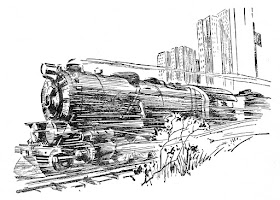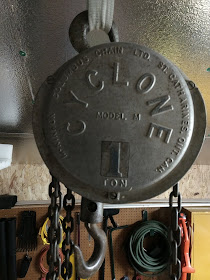Over the years I've encountered a few hand tools with this thistle logo. I always thought I'd discover that they were of Scottish or British origin.
Then, one day I picked up this monkey wrench and the mystery was solved:
The company seems to have specialized in this type of tool. Below, another example in my collection:
Most recently, I acquired the wrench below, showing that they also made tools for the Ford Motor Company:
Regular wrenches were part of their production:
Update Sept. 2020. A reader sends this example in, a large heavy wrench, 10 inches long with multiple size markings. He says he found it at a Restore! The bargains are still out there.
 |
thanks, Inno!
|
They also made stamped alligator wrenches, likely an earlier offering:

With a strong Scottish family history, Lachlan Ebenezer McKinnon was born in Brampton, Ontario but in 1878 moved to St. Catharines to partner with H.H. Mitchell in the manufacture of hardware for saddlery, harnesses and wagons. A four-man shop in the back of the store produced wagon gears and a patented adjustable leather dash for horse-drawn buggies. In 1892 McKinnon created a Buffalo, New York subsidiary, the McKinnon & Dash Hardware Company. He branched out into the manufacture of any number of products that made use of metal, including suspender buckles, as well as bicycles and chains. (In 1896, another factory was built in Troy, New York, which eventually became Plant 2 of the Hobart Manufacturing Company.)
In 1907, the McKinnon Dash and Hardware Company, now operating under the name of McKinnon Dash and Metal Works Company, was named the largest employer of skilled labor in the Niagara Peninsula by the Board of Trade. It's success didn't last. The company failed to make the transition to automobile dashboards and so disappeared.
 |
| 1905 |
When the First World War began, the original McKinnon company was well positioned to supply the allied horse-drawn armies for saddlery. However, they also manufactured shells and fuses and this gave them the expertise necessary to enter the automotive field after the war, where they pioneered the production of differential and transmission gears in Canada. McKinnon died in 1923 and his company became McKinnon Industries two years later. At some point they became the Canadian agents for the J.H. Williams Company, producing a variety of hand tools. In 1929, the General Motors Corporation purchased the firm, spinning off the hardware business in 1936. During WWII, the company was a huge producer of percussion fuses, fire-control mechanism, traversing and elevating units for 3.7 anti-aircraft guns, dynamotors for two-way radio transmission, handcrank generators, gyro gun sight motors, rear releases for machine guns and even torpedo drives. The plant for manufacture of these additional products necessitated expansion which practically doubled existing floor space. The number of employees increased from 1,800 in 1919 to 4,500 in 1943.
There's yet another chapter to the story. Back in 1905, the company took another direction. Up until then, most chain was made by fire welding. L.E.'s nephew, Archie McKinnon, applied the relatively new technology of electric welding to chain production. In 1909 the McKinnon Chain Company Limited is formed as an independent organization by the McKinnon Dash and Metal Works Company with plants in St. Catharines, Ontario, Canada, and Tonawanda, New York using the electric welding process to produce coil, ladder and 'sugar' chain, donkey and horse trace chain, lorry and plough trace chain, as well as tire chain for cars and trucks. In 1917 McKinnon Chain merged with the Columbus Chain Company. (Created around the turn of the 20th century, the Columbus Chain Company, located in Columbus, Ohio, was one of the earliest American suppliers of fire welded chain. The company had been founded by employees of the Hayden Iron Company, which since 1825 had been producing harness hardware but also manufactured coil chain.) In Canada it was known as McKinnon Columbus, and in America it was known as Columbus McKinnon. Either way it was a good fit for both companies. McKinnon brought superior technology, and Columbus brought a better grasp of the American market. In 1922, the company sold its share of the chain business to Columbus. The fortunes of the company actually declined until 1925 when board member Julius Stone bought the company. Self-educated, he had been a telegraph operator, coal miner, brakeman and fireman before founding the Seagrave Company to manufacture motorized fire engines in Columbus. Recognizing that electric welded chain made in New York was selling better than the fire-welded chain made in Ohio, he moved the company to Tonawanda, New York in 1927, shutting down the Columbus plant in 1931. Columbus McKinnon went on to absorb many other companies and to other technical accomplishments. For instance, in the early 1980's, Columbus McKinnon designed and manufactured the only shredder with a sole purpose of shredding steel belted passenger and truck tires. For a fascinating slideshow of the full history of the company, visit their website.
In 1904, Chisholm & Moore introduced the Cyclone high speed hoist, designed to be a previously unheard of 80 percent efficient. Chisholm & Moore used the electric welded chain that was made by Columbus McKinnon, and in 1928 Columbus McKinnon acquired the smaller hoist-making firm. The Cyclone hoist is still considered one of the most popular and reliable hand chain hoists ever designed. Today, it's made in Lisbon, Ohio.
Below, my Canadian-made McKinnon-Columbus Model M Cyclone. Unfortunately, the badge giving its lift rating was missing, but these days I only use it when I need to lift myself by my own bootstraps.
 Update Nov 2018.
Update Nov 2018.
A Quebec reader contributes pictures of his model M Cyclone chain hoist, rated at 1 ton, doing more work than the Dukes example, this one being used regularly for lifting snowblowers, bicycles etc- and for manually pulling stumps!





















































